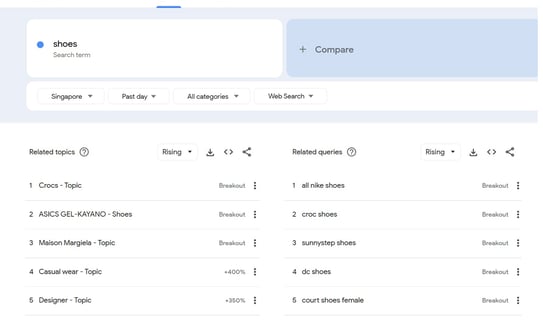Have you ever questioned whether the chosen keyword aligns with trending keywords for SEO optimization?
Yes, identifying trendy keywords using Google Trends can be a powerful way to stay ahead of the curve in content creation, marketing, and SEO. Here’s a step-by-step guide on how to identify trending keywords using Google Trends:
Explore Trending Searches
Click on the "Explore" tab to start analyzing trends.
You can view trending searches in real-time by clicking on "Daily Search Trends" or "Realtime Search Trends" (if available in your region).
These sections show what’s currently popular based on search volume spikes.
Search for Specific Keywords
Enter a keyword or topic in the search bar to see its trend over time.
Google Trends will show you the interest over time, related queries, and regional interest.
Use this to identify if a keyword is gaining or losing popularity. An Example when we type shoes into Google Trends


Tips for Identifying Trendy Keywords:
Look for Breakouts: Keywords labeled as "Breakout" in related queries are often the most promising.
Focus on Timeliness: Trending keywords often have a short lifespan, so act quickly.
Combine with Other Tools: Use tools like Google Keyword Planner, Ahrefs, or SEMrush to validate search volume and competition.
Analyze Interest Over Time
Look at the Interest Over Time graph to see how search interest for a keyword has changed.
A sharp upward spike indicates a trending keyword.
Compare multiple keywords to see which one is more popular.
Check Related Queries
Scroll down to the "Related Queries" section.
This shows keywords that people are searching for alongside your main keyword.
Look for terms labeled as "Breakout"—these are keywords with a significant increase in search volume.
Filter by Region and Time
Use the filters to narrow down trends by:
Region: Identify trends specific to a country, state, or city.
Time Range: Choose between past hour, day, week, month, or custom ranges to see short-term or long-term trends.
Compare Keywords
Use the "Compare" feature to analyze multiple keywords side by side.
This helps you identify which keyword is more popular or has a higher growth potential.
Explore Trending Categories
Click on "Categories" to see what’s trending in specific industries (e.g., health, technology, entertainment).
This can help you find niche-specific trending keywords.
Leverage Seasonal Trends
Use the "Year in Search" feature (released annually by Google) to identify seasonal trends and recurring popular topics.
Export Data
Export the data to CSV for further analysis or to track trends over time.
We Code the Future of Digital Marketing
Support
Consulting
enquiries@cglobaltech.com
© 2025. All rights reserved.


